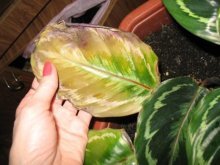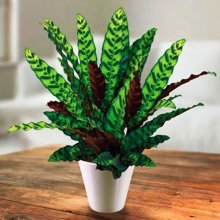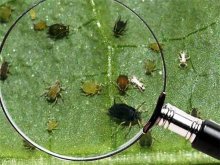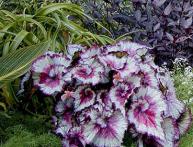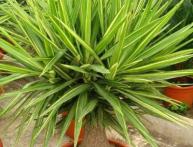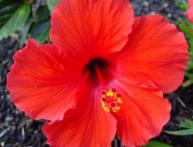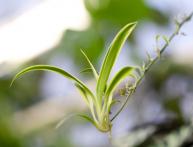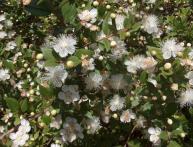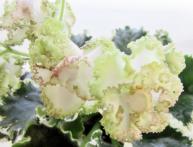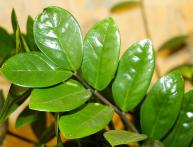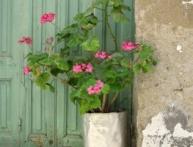Calathea Lansifolia, home care, secrets of successful cultivation
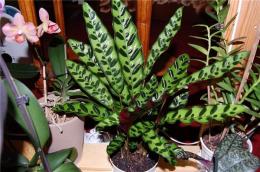
Calathea comes from the tropics, but takes root well in an apartment. The plant belongs to the family arrowroot. Flower growers appreciate it for its interesting leaf patterns. Calathea lancifolia, which requires some skill to care for at home, can become a picturesque decoration of any room. The lover should familiarize himself with the whims of the flower in advance.
Content:
- Where are you from?
- How to ensure optimal conditions
- Further care - replanting, fertilizing, pruning
- Features of calathea propagation
- Problems that may arise during cultivation
- What diseases and pests is it susceptible to?
Where are you from?
The homeland of calathea is Latin America. It grows naturally in Brazil, where it is used to weave baskets, make flower pots and wrapping paper. In its native region, flowering time occurs in late spring or early summer.
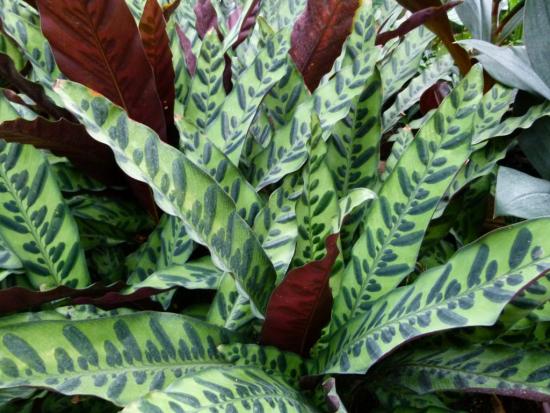
Calathea lancifolia is one of the most unpretentious and memorable members of the family and is the most popular. However, it requires increased attention and skills. care.
The leaves have a wavy, elongated shape, reaching a length of 70-80 cm. The pattern resembles small dark green leaves on a branch, the reverse side is brown in color.
Bloom rarely arouses admiration and looks rather modest. Calathea is loved for its large, unusual leaves.It immediately attracts attention and stands out on the shelves of flower shops.
How to ensure optimal conditions
Calathea Lansifolia, the photos of which are very picturesque, requires careful care at home. The plant is quite resilient, but in order for it to show all its charm, you will have to make an effort.
The soil
One of the most important elements of care is the right choice soil. Calathea is very picky about it. Specialized departments sell ready-made soil for rhododendrons or azaleas. The mixture itself can be prepared by mixing 0.5 parts of sand and 1 part of humus, peat and leaf soil.
Location
Choosing a good place is not so easy. Calathea does not like darkness, which makes its leaves faded, small and slows down their growth. Exposure to direct sunlight is generally harmful. The best solution would be to place a flowerpot with a flower in partial shade.
Watering
Hard water is a bad source glaze. Ideally, you should purchase a filter that will help cleanse it of excess calcium and magnesium. In its absence, settling is practiced.
She is also picky about water temperature. It should not be below room temperature, but rather warm. In summer, the plant requires frequent watering, in winter – less often. To prevent the rhizomes from being damaged, excess liquid should be drained from the pan.
Air parameters
The higher the humidity in the room, the better (minimum 50%). Professional flower growers provide special florariums for the plant, since it is difficult to achieve sufficient humidity in an ordinary apartment. For beginners, regular spraying of the space near the flowerpot will help.
The optimal temperature is considered to be from 16 to 22 C. The main thing is to avoid sudden changes.With large temperature amplitudes, the leaves lose their elasticity and may even begin to rot. Calathea does not tolerate drafts.
The requirements listed above may seem excessive to a novice gardener. But if you follow the rules of care, the plant will delight you with its beauty for a long time.
Further care - replanting, fertilizing, pruning
After all the basics of care have been studied, you can familiarize yourself with the features of feeding and replanting.
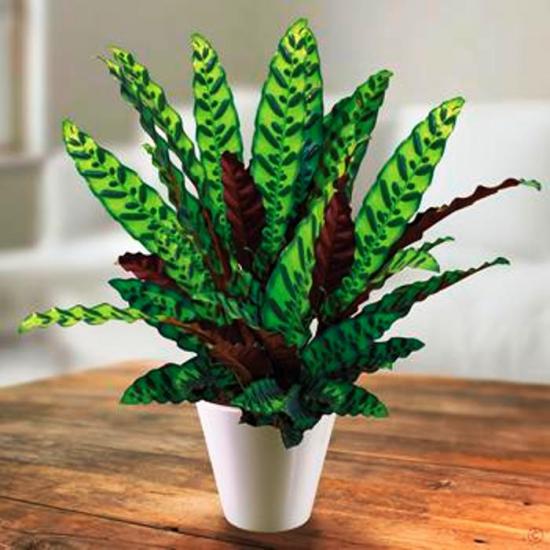
Fertilizer
Calathea lancifolia does not need permanent feeding. The exception is the growing season. For lancifolia this is the period from April to mid-September. Use half the dose of complex liquid fertilizers. Fertilizer should be applied once every three weeks.
Trimming
The plant does not require stem pruning. Simply removing dried leaves is enough.
Transfer
The rules are as follows:
- Choose a pot of small size and depth. For better drainage and air access, crushed stone or sand with foam is placed at the bottom.
- The soil should be well loosened. Under no circumstances should we compact the soil, as this may cause rotting.
- At the time of transplanting the plant, remove the soil from the rhizome (without applying force). We place the roots in the middle of the container. Leave at least 2 cm from the roots to the drainage layer.
- After transplantation, moderate watering should be observed. Water is needed when the top layer of soil becomes visually dry. Drought will cause the leaves to wilt and curl.
Young plant recommended transplant Every year. The best period for this is the beginning of spring. Upon reaching the age of three, a transplant is required every 2 years.
Features of calathea propagation
If you want to add another Calathea lancifolia to your home, or want to share with friends, there are several ways reproduction such a flower.
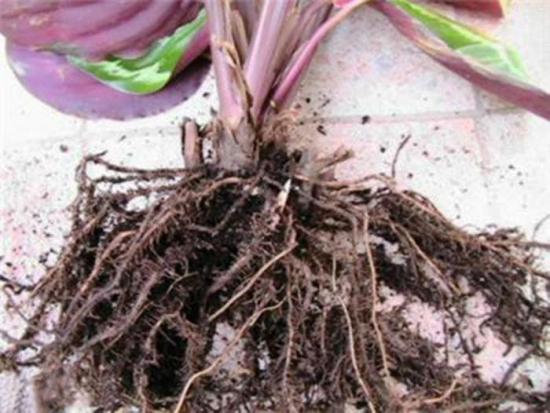
Division
The most popular way. Division is carried out at the time of flower transplantation. We choose a pot with a diameter of 7-9 cm. While the plant will take root in a new place, it is necessary to carefully maintain the correct conditions: regular watering,
warm room (at least 21-22 C), sufficient humidity, fertilize no more than once a month.
Planting seeds
This method is more complex and time-consuming. In practice, it is rarely used due to the low germination percentage. Planting in the soil occurs at an air temperature of 24 C. If sprouts appear, they are transplanted into pots of standard sizes for the flower. Further care is carried out according to standard rules.
Separation of cuttings
The stem above the soil is separated from the plant and planted in moist soil. We create a greenhouse effect using film. Polyethylene is removed only after the calathea takes root.
Problems that may arise during cultivation
On the way to growing Calathea lancifolia, a gardener may encounter certain difficulties. In most cases, this is due to improper care. After all, the flower is accustomed to the natural climate of the tropics; in an apartment it requires the same parameters.
The following problems may arise.
No flowering
If the plant is not blooms, the soil should be checked for compliance with the requirements and the air parameters should be adjusted. The room may be too dark.
Leaves have curled or dry spots have appeared
Drafts or too dry air may be to blame.
The foliage has turned yellow
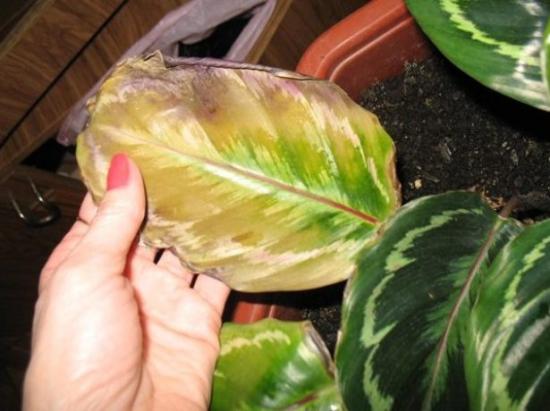
The reason lies in low temperature, too frequent fertilization, too intense or insufficient watering.
The leaves have acquired a thin, elongated shape
Most likely the plant is not getting enough sun. Choose a lighter area. Provide supports to prevent leaves from breaking.
Yellow spots
Yellow spots can form when exposed to direct sunlight. A common problem when placing a flower on a windowsill.
Dark spots
The reason is too frequent spraying.
Due to the capriciousness of the flower, problems with its growth and appearance may arise. The first step is to check the compliance of the conditions.
What diseases and pests is the flower susceptible to?
Calathea lancifolia may suffer from some misfortunes.
Sooty mushroom
A symptom of parasite infection is a soot-like coating. To eliminate it, you need to wipe the affected areas with soapy water.
Spider mite
Infection is indicated by the formation of thin cobwebs on the lower leaves. With time parasite leads to yellowing and falling of leaves. The disease is caused by dry air. For treatment, chemicals are used that are sold in specialized departments.
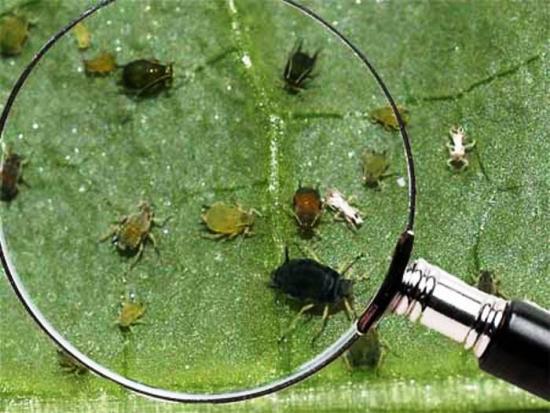
Shchitovka
Insects suck out the sap, which causes the leaves to dry out. To eliminate the problem, you need to treat it with a solution of laundry soap.
Thrips
Appears in dry, warm air. Expressed by the appearance of white dots on the leaves. Causes the plant to turn brown. The flower is treated with a store-bought product. A week after the parasite is removed, fertilizing is applied.
Calathea lancifolia is one of the most striking and memorable representatives of its species.Although the flower comes from tropical countries, it can be grown indoors.
In order for the plant to please its owner, you will have to work a little. Follow the maintenance rules and calathea will give you a lot of aesthetic pleasure.
Calathea Lansifolia - care at home, video on how to grow it correctly:


